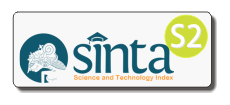Variables Affecting Extreme Poverty of Agricultural Sector Households in Indonesia
Abstract
Keywords
Full Text:
PDFReferences
Arfiyanto, H. (2015). Pengaruh Pengaturan Tempat Tinggal (Living Arrangement) terhadap Kemiskinan dalam Rumah Tangga di Indonesia (Analisis Data Susenas 2013). Depok: Universitas Indonesia.
Bokosi, F. K. (2007). Household Poverty Dynamics in Malawi: A Bivariate Probit Analysis. Journal of Applied Sciences, 7(2), 258–262. https://doi.org/10.3923/jas.2007.258.262
Borko, Z. P. (2017). Determinants of Poverty in Rural Households (The Case of Damot Gale District in Wolaita Zone) A Household Level Analysis. International Journal of African and Asian Studies, 29.
BPS. (2022). Penghitungan dan Analisis Kemiskinan Makro Indonesia Tahun 2022. Jakarta: Badan Pusat Statistik.
Direja, S. (2021). Pengaruh Karakteristik Individu Kepala Rumah Tangga terhadap Kemiskinan di Provinsi Banten Tahun 2020. Jurnal STEI Ekonomi, 30(02), 01–10. https://doi.org/10.36406/jemi.v30i02.475
Fachrurrozi, K., Fahmiwati, & Hakim, L. (2021). Pengaruh Kemiskinan dan Pengangguran Terhadap Kriminalitas di Indonesia di Tahun 2019. Jurnal Real Riset, 3(2), 173–178.
Fatikhurrizqi, A., & Kurniawan, B. D. (2022). Peran Bantuan Sosial dalam Pengentasan Kemiskinan Ekstrem di Jawa Timur Tahun 2020. Prosiding Seminar Nasional Official Statistics 2022, 1027–1036.
Garza-Rodríguez, J. (2004). The Determinants of Poverty in Mexico:2002.
Gassner, A., Harris, D., Mausch, K., Terheggen A., Lopes, C., Finlayson RF., Dobie, P. (2019). Poverty eradication and food security through agriculture in Africa: Rethinking objectives and entry points, Outlook on Agriculture, 48 (2), 309-315.
Haddad, L., & Ahmed, A. (2003). Chronic and Transitory Poverty: Evidence from Egypt, 1997–99. 31(1), 71–85.
Haryanto, T., Erlando, A., & Rositawati, V. (2020). Determinan Kemiskinan Rumah Tangga di Jawa Timur. Jurnal Ekonomi Pembangunan 9(2), 89–105. https://doi.org/10.23960/jep.v9i2.97
Hosmer, D. W., & Lemeshow, S. (2000). Applied Logistic Regression Second Edition. New York: John Wiley & Sons, Inc.
Hosmer, D. W., Lemeshow, S., & Sturdivant, R. X. (2013). Applied Logistic Regression. New York: John Wiley & Sons, Inc.
Khalid, U., Shahnaz, L., & Bibi, H. (2005). Determinants of Poverty in Pakistan: A Multinomial Logit Approach. Lahore Journal of Economics, Department of Economics, The Lahore School of Economics, vol. 10(1), 65–81.
Kuncoro, M. (2010). Dasar-Dasar Ekonomika Pembangunan. Yogyakarta: UPP STIM YKPN.
Maharsi, R. W., & Hadi, S. (2022). Pemilihan Metode Terbaik Support Vector Machine (SVM) Dan Regresi Logistik Biner Untuk Klasifikasi Status Kemiskinan Rumah Tangga Di Provinsi Lampung Tahun 2019. Jurnal Siger Matematika 3(2), 31–44.
Moeis, F., Dartanto, T., Moeis, J., Ikhsan, M. (2020). A longitudinal study of agriculture households in Indonesia: The effect of land and labor mobility on welfare and poverty dynamics. World Development Perspectives 20.
Mutia, R. (2020). Analisis Penyebab Kemiskinan Petani Sektor Perkebunan Rakyat di Provinsi Aceh, Berdasarkan Faktor Individu dan Rumah Tangga. Kinerja, 17(1), 129–139.
Nainggolan, F., & Saragih, M. T. Br. (2022). Kesejahteraan Rumah Tangga Pertanian di Provinsi Sumatera Utara. 1(1).
Pungky Sumadi. (2022). Strategi Penurunan Kemiskinan dan Ketimpangan di Provinsi DI Yogyakarta. Forum Pembangunan Daerah, DI Yogyakarta.
Puspitasari, F., & Triscowati, D. W. (2022). Determinan Rumah Tangga Pertanian Miskin di Provinsi Kalimantan Utara. Jurnal Ekonomika 3(1), 19-30.
Putra, A. D., Martha, G. S., Fikram, M., & Yuhan, R. J. (2021). Faktor-Faktor yang Memengaruhi Tingkat Kriminalitas di Indonesia Tahun 2018. Indonesian Journal of Applied Statistics, 3(2), 123–131. https://doi.org/10.13057/ijas.v3i2.41917
Raharyanti, F. (2013). Hubungan Indikator Kemiskinan dengan Kepemilikan Sanitasi Layak di Provinsi Gorontalo Tahun 2010. Hearthy Jurnal Kesehatan Masyarakat, 1(1).
Rahmawati, Y. I. (2006). Analisis faktor-faktor yang mempengaruhi kemiskinan rumah tangga di Kabupaten Pacitan Propinsi Jawa Timur. Bogor: Institut Pertanian Bogor.
Rasyid, R., Agustang, A., Agustang, A. T. P., Bastiana, & Najamuddin. (2020). Analisis Faktor Yang Mempengaruhi Status Kemiskinan Rumah Tangga Pada Wilayah Central Bussines District (CBD) di Kota Makassar. Majalah Geografi Indonesia, 34(1), 43–52. https://doi.org/10.22146/mgi.54461
Rini, A. S., & Sugiharti, L. (2016). Determining Factors of Poverty in Indonesia: Household Analysis. Jurnal Ilmu Ekonomi Terapan, 1(2), 80–95.
Rosmika, N. (2021). Kemiskinan Rumah Tangga Sektor Informal di Aceh. Ekombis Jurnal Fakultas Ekonomi, 7, 65–74.
Rozanti, Y. D., Khusaini, M., & Prasetyia, F. (2021). Determinants of Household Poverty Status in Kediri City. Journal of Indonesian Applied Economics, 9(1).
Samputra, P. L., & Ramadhani, A. W. (2019). Efektifitas Bantuan Sosial Dalam Penanggulangan Kemiskinan Di Tengah Perlambatan Ekonomi Indonesia Dengan Pendekatan Non-Parametrik. Jurnal Perspektif Ekonomi Darussalam, 5(1), 9–31. https://doi.org/10.24815/jped.v5i1.14227
Satrio, I. (2018). Sektor Pertanian: Faktor Utama Penentu Kemiskinan Jawa Barat. Agriekonomika, 7(2), 188. https://doi.org/10.21107/agriekonomika.v7i2.4707.
Sumarsono, H., Yusida, E., Alma’amun, S. (2022). The Impact of Macroeconomic Effect and Fiscal Policy on Poverty in Indonesia. Jurnal Ekonomi dan Studi Pembangunan, 14 (2).
Lampiran I Peraturan Presiden Nomor 18 Tahun 2020 tentang Rencana Pembangunan Jangka Menengah Nasional Tahun 2020-2024, (2020).
Shepherd, A. (2007). Chronic Poverty: Some policy implications. Development, 50(2), 48–55. https://doi.org/10.1057/palgrave.development.1100381
Suwartana, I. G. M., & Siagian, T. H. (2022). Determinan Status Kemiskinan Rumah Tangga Pertanian. Jurnal Sosial Ekonomi pertanian, 19.
Teguh, D., & Nurkholis, N. (2013). The determinants of poverty dynamics in Indonesia: evidence from panel data. Bulletin of Indonesian Economic Studies, 49(1).
TNP2K. (2022). Target for Eliminating Extreme Poverty by 2024: Ambitious, But Not Impossible. https://www.tnp2k.go.id/articles/target-for-eliminating-extreme-poverty-by-2024-ambitious-but-not-impossible
Todaro, M. P., & Smith, S. C. (2003). Pembangunan Ekonomi di Dunia Ketiga. Jakarta: Erlangga.
United Nations. (1984). Handbook of Household Surveys. New York: United Nations.
Widyanti, W., Suryahadi, A., Sumarto, S., & Yumna, A. (2010). The Relationship Between Chronic Poverty and Household Dynamics: Evidence from Indonesia. SSRN Electronic Journal. https://doi.org/10.2139/ssrn.1537080
World Bank. (2020). Poverty and Shared Prosperity 2020: Reversals of Fortune. Washington DC: World Bank
Yakubu, Y. (2021). Micro Correlates of Extreme Poverty in Nigeria. International Journal of Intellectual Discourse, 4(4), 31–44..
Zuhri, K. (2019). Ketimpangan Akses Energi Listrik dan Kemiskinan Di Indonesia. Bogor: Institut Pertanian Bogor.
Refbacks
- There are currently no refbacks.
ISSN (Print) 2086-1575 ISSN (Online) 2502-7115

This work is licensed under a Creative Commons Attribution-NoDerivatives 4.0 International License.







